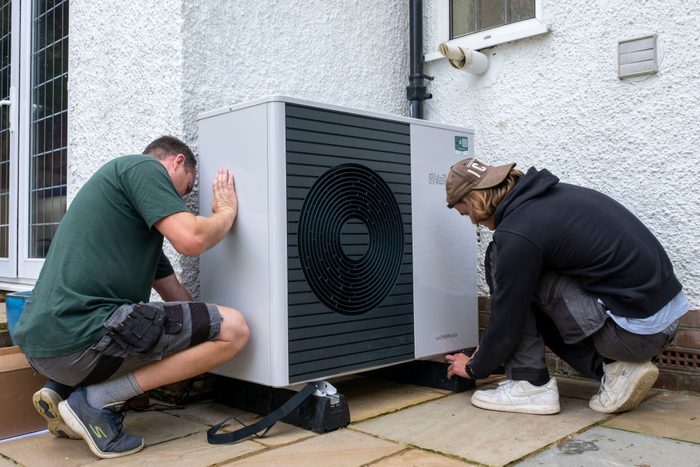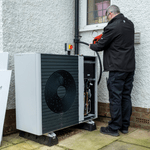How To Buy a Heat Pump in 2023

New energy incentives make this a great time to install or upgrade a heat pump.
Our editors and experts handpick every product we feature. We may earn a commission from your purchases.
The year 2023 may be the best for homeowners buying a new heat pump. The new Inflation Reduction Act (IRA) includes incentives for upgrading a home’s energy efficiency, including tax rebates and discounted purchasing.
On This Page
What Is a Heat Pump?
While traditional furnaces generate warmth via flames or a heating element, a heat pump pushes existing heat into a colder region. Heat pumps channel excess heat out of your home during the summer and into it during the winter. Since they’re only moving heat rather than generating it, they use far less energy than traditional furnaces.
If you’re considering an upgrade to your home’s heating system, then make sure you know the difference between heat pump versus furnace.
Types of Heat Pumps
Here are some of the most common:
Standard heat pump
Sometimes called air source heat pumps, these use ambient air temperature and feature two sets of coils, one indoors and the other outdoors. They often come with a backup electrical heating element in case the exterior temperature drops too low for the pump to properly function.
Dual fuel heat pump
These operate until the ambient temperature drops too low, when it switches over to an alternate fuel source. Mark Woodruff, outdoor product manager at Trane Residential, compares them to “a hybrid car that runs on electricity as often as possible and switches to gas as needed.”
Cold climate heat pump
Colder temperatures call for specialized heat pumps. Cold climate air source heat pumps (ccASHPs) operate in temperatures of five degrees or lower.
Mini-split heat pump
These have a single outdoor unit tied to multiple indoor units (or “heads”) that distribute the conditioned air in the home. Users can set different temperatures for each head. These are a great choice for a home without ductwork.
Geothermal heat pump
Geothermal models exchange heat with temperatures below ground to shed excess heat or cold from your home. Geothermal units are normally installed during construction rather than as an upgrade.
Heat Pump Features and Considerations
Here are some things to keep in mind when looking for a heat pump:
Sizing
Getting the right sized HVAC system for your home is important. An undersized unit will struggle to heat/cool the home. An oversized one will hit the desired temperature before it completes its cycle, resulting in frequent stops/starts that will shorten its lifespan.
Heat pump sizes are described in tons. A “ton” in HVAC lingo is 12,000 British Thermal Units (BTUs), so a four-ton heat pump produces 48,000 BTUs per hour. Properly sizing a heat pump accounts for the volume of the home, sun exposure, insulation and more.
Climate appropriateness
Almost all modern heat pumps are effective in temperatures as low as 25 degrees, with some dipping down to zero. If you live in a cold climate, check the manufacturer’s specs on operating temperatures, or look for a dual fuel or ccASHA heat pump.
Energy efficiency
Look for Energy Star certification. If possible, opt for a unit with a variable speed compressor and fan, which will work harder when needed and coast along with minor energy use when it’s not.
How Much Do Heat Pumps Cost?
A standard heat pump installation runs from $5,000 to $8,000.
This assumes a typical three-bedroom, single-family home with two stories and a pre-existing duct system. Features that can drive up heat pump pricing include size, efficiency, variable-speed blowers and cold climate capabilities.
What Incentives Are Available for Buying Heat Pumps?
The IRA rolled out a range of incentives tied to heat pumps, specifically in the High Efficiency Electric Home Rebate Act (HEEHRA). A household may qualify for a tax credit or rebate on heat pumps and heat pump water heaters purchased after Jan. 1, 2023.
Rebates are available on a sliding scale to households with income less than 150% of the area median income. Tax credits are worth up to 30% of the installed cost, capped at $2,000.
That the IRA addresses installation costs, as well as materials costs, is a true game changer. Francois Lebrasseur, utility sector manager at A. O. Smith, says basing the credits on the full installation cost means homeowners will enjoy “huge upfront savings and in some instances, potentially break even.”
Woodruff also credits the IRA for covering “hidden costs” of installation, like running 240-volt wiring or upgrading a home’s breaker panel.
Heat Pump Maintenance
Heat pumps are relatively low maintenance. Two easy steps will go a long way toward keeping your heat pump running smoothly.
- Change the filter as needed: The biggest thing you can do is also the simplest. Use a properly-sized filter and change it regularly. A heat pump with a dirty filter is like a smoker running a marathon. He or she might finish, but their lungs will work a lot harder than they should.
- Check the external unit: It needs about 18 inches of clear space around it to function properly. Remove leaf or snow buildup during the fall and winter, and trim back any shrubs or tree branches that encroach during the spring and summer.


